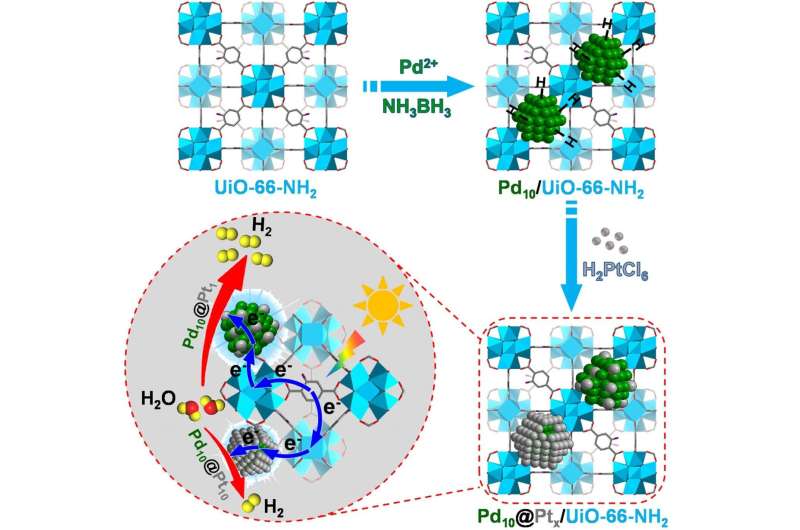The surface charge state of co-catalyst plays an important role in photocatalysis. However, the regulation on surface charge state of co-catalysts especially by changing their microstructures and coordination environment almost remains unexplored. Recently, Hai-Long Jiang's research group from the University of Science and Technology of China made very interesting progress in this aspect by fabricating single-atom alloy cocatalyst. Credit: Science China Press
Photocatalysis, converting solar energy into chemical energy, has been recognized to be a very promising solution to current energy and environmental issues. The performance of the photocatalytic system depends largely on the surface charge state of active sites (usually co-catalysts), as the Schottky junction between photosensitizer and co-catalyst facilitates charge transfer between them and finally to reactant molecules, promoting the adsorption and activation of the latter.
In contrast to the existing reports centered on co-catalysts, such as the development of non-noble metals, particle size and distribution control, exposed crystal facets and their interface contact with photosensitizers, the regulation on the surface charge state of co-catalysts by changing their microstructures provides vast opportunities for boosting photocatalysis, yet remains extremely rare.
In this work, Dr. Jiang's research group from the University of Science and Technology of China has achieved the goal of optimizing Pt surface charge states via the control of bimetallic Pd@Pt microstructure and Pt coordination environment.
The bimetallic core-shell-structured Pd@Pt NPs have been in situ fabricated and stabilized by a photosensitive and representative metal-organic framework (MOF), UiO-66-NH2. The microstructure of the Pd10@Ptx co-catalyst can be precisely controlled from core-shell to single-atom alloy (SAA), during which the Pt coordination environment changes, by precisely and simply tuning the Pt content.
Given the different working functions of Pd and Pt, the charge between Pd and Pt is redistributed, accompanied by Pt coordination environment change, thus achieving the surface charge state regulation of Pt sites.
As a result, all Pd@Pt/MOF present excellent photocatalytic hydrogen production activity due to the electron-rich Pt sites benefited from charge redistribution effect. Moreover, the optimized Pd10@Pt1/MOF composite with SAA co-catalyst, which features the most electron-rich Pt, exhibits an exceptionally high photocatalytic hydrogen production activity, far surpassing its corresponding counterparts (see in image).
This is the first report on SAA co-catalysis toward photocatalysis. It provides the design strategy and synthetic protocol for the fabrication of SAA catalysts and opens up a new avenue to SAA-based photocatalysis. In addition, as an alternative to the classical Schottky junction strategy, this work introduces a novel approach to charge state optimization by regulating the co-catalyst microstructure (especially the coordination environment control), toward enhanced photocatalysis.
More information: Yating Pan et al, Precise fabrication of single-atom alloy co-catalyst with optimal charge state for enhanced photocatalysis, National Science Review (2020). DOI: 10.1093/nsr/nwaa224
Provided by Science China Press























